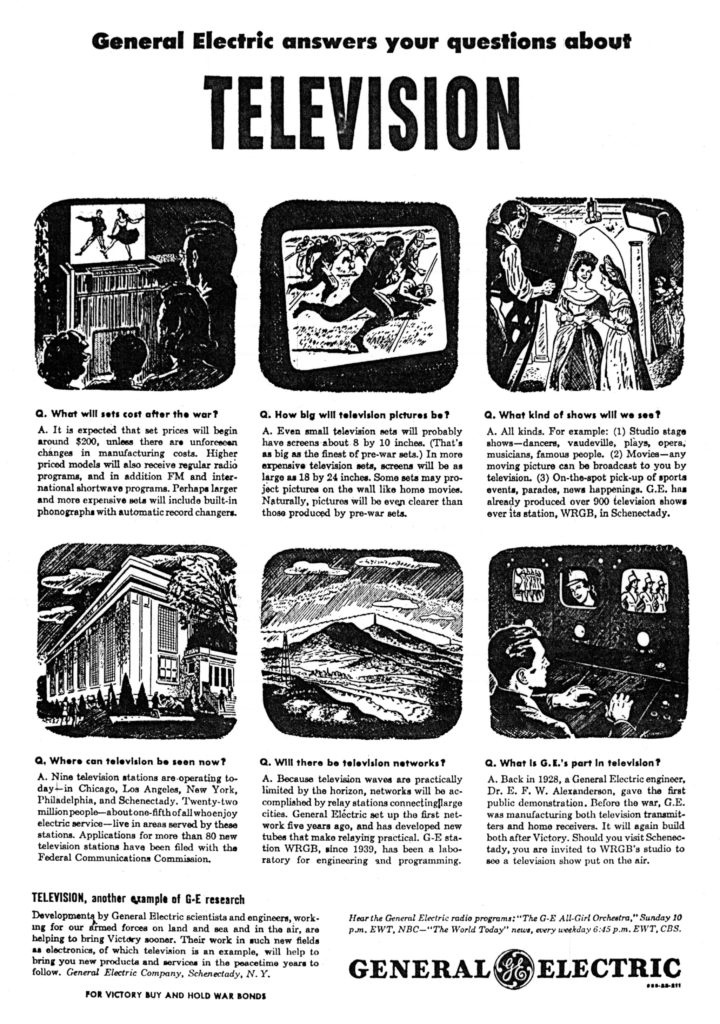On March 14, 1945, a few months prior to their advertisement promoting “Plastic” in both military and civilian contexts, GE ran an advertisement – with a similar 6-section graphic and textual design – presenting and explaining the economic, technical, and cultural aspects of “Television” for the postwar world.
In light of the world of 2017, there’s something almost quaint about the the content of and mindset behind this advertisement, exemplified by the description of the kind of programming that was expected to be available: studio stage shows; movies; sports events; news. This was a natural reflection of the entertainment and informational “material” then available to the public, much already extant on radio. Understandably, the ad’s writers could not have foreseen the technological, cultural, and economic changes that – acting in synergy – would sweep the world in the ensuing decades, and continue to do so now. In their lack of knowledge about the future of entertainment, perhaps the copy-writers were fortunate.
An example, perhaps, of the way that the manifestation and anticipated use of any new technology, is – at the time of the introduction of that technology – seen in the immediate intellectual context of that time itself.
 Q. What will sets cost after the war?
Q. What will sets cost after the war?
A. It is expected that set prices will begin around $200, unless there are unforeseen changes in manufacturing costs. Higher priced models will also receive regular radio programs, and in addition FM and international shortwave programs. Perhaps larger and more expensive sets will include built-in phonographs with automatic record changers.
Q. How big will television pictures be?
A. Even small television sets will probably have screen about 8 by 10 inches. (That’s as big as the finest of pre-war sets.) In more expensive television sets, screens will be as large as 18 by 24 inches. Some sets may project pictures on the wall like home movies. Naturally, pictures will be even clearer than those produced by pre-war sets.
Q. What kind of shows will we see?
A. All kinds. For example: (1) Studio stage shows – dancers, vaudeville, plays, opera, musicians, famous people. (2) Movies – any moving picture can be broadcast to you by television. (3) On-the-spot pick-up of sports events, parades, news happenings. G.E. has already produced over 900 television shows over its station, WRGB, in Schenectady.
Q. Where can television be seen now?
A. Nine television stations are operating today – in Chicago, Los Angeles, New York, Philadelphia, and Schenectady. Twenty-two million people – about one-fifth of all who enjoy electric service – live in areas served by these stations. Applications for more than 80 new television stations have been filed with the Federal Communications Commission.
Q. Will there be television networks?
A. Because television waves are practically limited by the horizon, networks will be accomplished by relay stations connecting large cities. General Electric set up the first network five years ago, and has developed new tubes that make relaying practical. G-E stations WRGB, since 1939, has been a laboratory for engineering and programming.
Q. What is G.E.’s part in television?
A. Back in 1923, a General Electric engineer, Dr. E.F.W. Alexanderson, gave the first public demonstration. Before the war, G.E. was manufacturing both television transmitters and home receivers. It will again build both after Victory. Should you visit Schenectady, you are invited to WRGB’s studio to see a television show put on the air.
TELEVISION, another example of G-E research
Developments by General Electric scientists and engineers, working for our armed forces on land and sea and in the air, are helping to bring Victory sooner. Their work in such new fields as electronics, of which television is an example, will help to bring you new products and services in peacetime years to follow. General Electric Company, Schenectady, N.Y.
Hear the General Electric radio program: “The G-E All-girl Orchestra,” Sunday 10 p.m. EWT, NBC – “The World Today” news, every weekday 6:45 p.m. EWT, CBS.
Deprecated: Function get_magic_quotes_gpc() is deprecated in /home3/emc2ftl3/public_html/wp-includes/formatting.php on line 4365
Deprecated: Function get_magic_quotes_gpc() is deprecated in /home3/emc2ftl3/public_html/wp-includes/formatting.php on line 4365
Deprecated: Function get_magic_quotes_gpc() is deprecated in /home3/emc2ftl3/public_html/wp-includes/formatting.php on line 4365